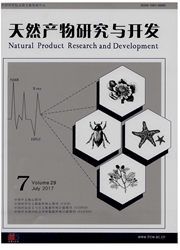

 中文摘要:
中文摘要:
从胜利油田被污染土壤中筛选出一株能够以萘为唯一碳源的菌株W1,经形态和生理生化以及16SrD.NA测序分析,初步鉴定为沙雷氏菌属。其最适生长条件为35℃,pH7.5。该菌对盐及萘有较好的耐受性。当培养基盐质量浓度为30g/L,底物萘质量浓度为100mg/L时,培养3d后,其萘降解率仍可达到80.9%。当萘浓度为800mg/L时,仍具有一定的降解作用,降解率为15.8%。通过对菌株降解原油前后组分的GC.MS分析,以及检测其降解多种底物后的吸光度,得出该菌能利用苯酚、甲苯、苯甲酸、1.萘酚、丙酮、辛烷生长,对原油中组分C20-C23,C33-C36的直链烃有较好的降解效果。经UV-Vis扫描其降解中间产物,初步判断其萘降解生物途径为邻苯二酚途径,萘首先被其降解生成水杨酸,而后转化为邻苯二酚,开环并生成一系列小分子物质,最后进入三羧酸循环。
 英文摘要:
英文摘要:
A bacterial strain W1 which could use naphthalene as the sole carbon source was isolated from oil-polluted soil of Shengli oil field. It was preliminarily identified that W1 belonged to Serratia sp. by the morphology, physiological- biochemical characteristics and sequencing analysis of the 16S rDNA. The optimal temperature and pH for its growth were 35 ℃ and 7.5. It could tolerate the high concentration of NaC1 and naphthalene. Under the treatments of 30 g/L NaCl,the degradation rate of naphthalene was 80.9% after culture for 3 days when the naphthalene concentration was 100 mg/L,even the degradation rate reached 15.8% when 800 mg/L. According to the analysis of GC-MS and the ab- sorbance measured of different substrates, the W1 strain could utilize other aromatic hydrocarbons, such as phenol, meth- ylbenzene, benzoic acid, 1-Naphthalenol, acetone and octane for growth. It also could degrade aliphatic hydrocarbon of C20-C23 ,C33-C36 in crude oil. The pathway of naphthalene degradation was measured by scanning the metabolic interme- diates of degradation with UV-Vis. The possible degradation pathway of W1 strain was catechol pathway. Naphthalene was first turned into salicylic acid, and then pyrocatechol, small molecule substance by opening benzene ring, finally en- tered the tricarboxvlic acid cycle.
 同期刊论文项目
同期刊论文项目
 同项目期刊论文
同项目期刊论文
 期刊信息
期刊信息
